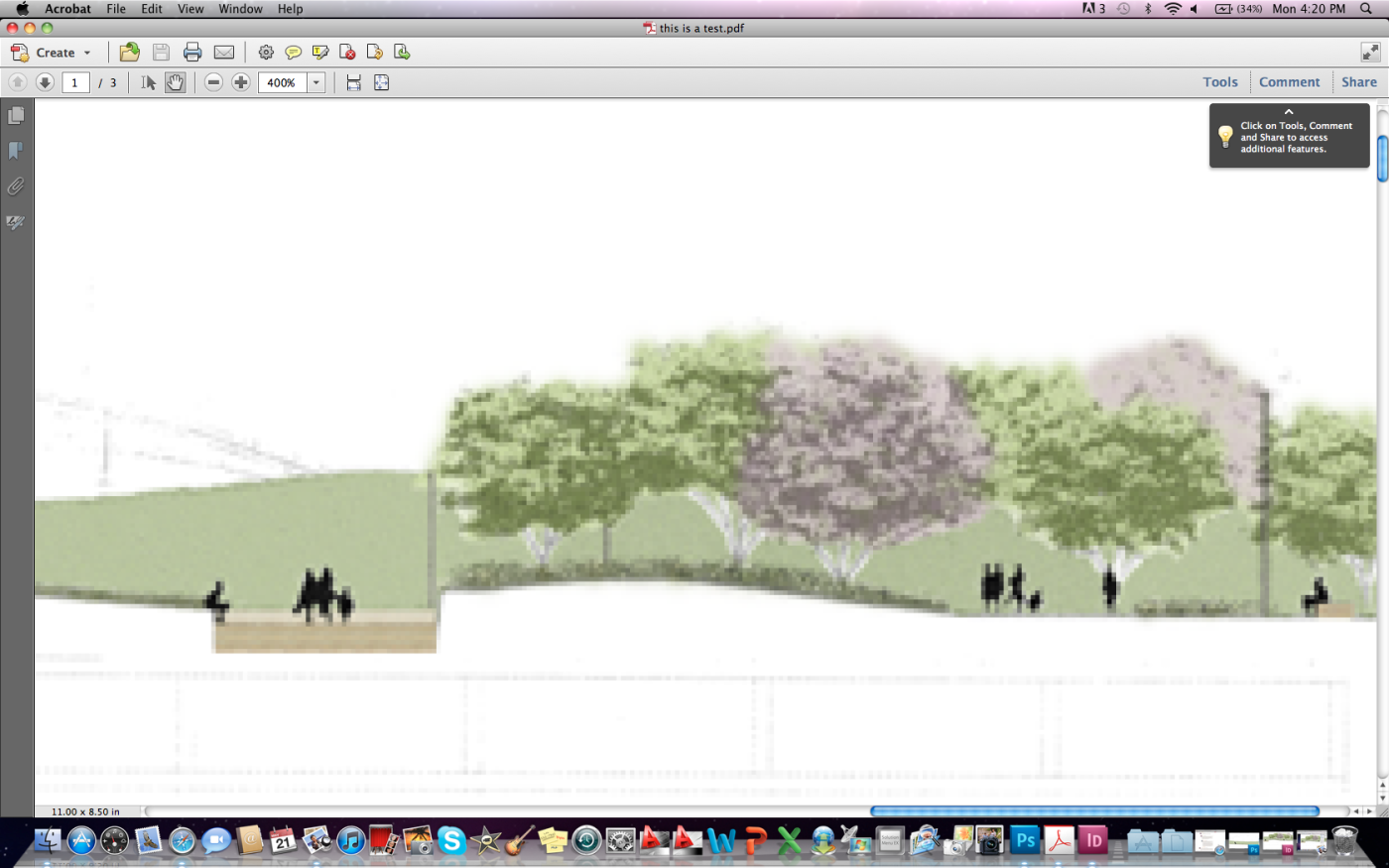Landscape Architecture for Landscape Architects › Forums › PORTFOLIO & RESUME › Image quality when saving InDesign doc as PDF Interactive vs. PDF Print
- This topic has 1 reply, 4 voices, and was last updated 13 years, 5 months ago by
 Chris Whitted.
Chris Whitted.
-
AuthorPosts
-
May 14, 2012 at 8:49 am #157528
 MGParticipant
MGParticipantI have noticed something as I have been testing out how my portfolio would look if I exported the InDesign document as Interactive vs. Print. The photoshop images e.g. bitmap are blurry. The vector drawings are still clear. I do realize that vectors can be resized and blown up and they still maintain their appearance as someone had mentioned earlier. My question is how can I fix the problem at this point? What can I do make the bitmap images appear sharp as an interactive file? I want to have the option of emailing and uploading my portfolio on the web as well.
May 14, 2012 at 8:20 pm #157541 Chris WhittedParticipant
Chris WhittedParticipantThe most likely issue is the Adobe Preset for pdf that you’re using. In particular, the options in the Compression group. There are two factors that affect quality for each of three types of images – downsampling, where if your original image is over a certain ppi it will reduce it to a lower ppi; and image quality, which sets the level of loss in lossy compression formats (like jpgs). I don’t have the interactive option (though there are some interesting results Googling for “pdf interactive vs pdf print”) so I can’t see what things are set to nor do I know anything about your original files, but I create my own preset for pdf generation based on the High Quality Print preset so I know what all of those things are set to. And for the most part I make sure the pdf writer doesn’t do much in the way of compression because I’ve already done it to the images myself before linking them to the Indesign document.
Beware that this is where things are going to start getting tricky with quality vs file size. There are other options that affect that ratio, but it’s entirely possible you won’t be able to get the quality you want, or at least the same level as for print, in an emailable file size. Downloading is a different story, since it depends on how large a file you think your audience is willing to wait for. You may need to use multiple preset settings to generate different quality levels of your document depending on purpose.
May 15, 2012 at 2:29 am #157540 Jason T. RadiceParticipant
Jason T. RadiceParticipantSaving to bitmap is one of the first problems. .bpm files really lose a lot of clarity and resolution. They are fine for low-res stuff like web pages. Stick with large, high quality jpegs, or if you need absolute clarity, TIFs. Also, do not scale the image to export into InDesign, assign the size in InDesign and let it compress the image file on output. Also, make sure the setting for PDF output do not have the image downsampled too much.
May 16, 2012 at 5:45 pm #157539 Blair LeJeuneParticipant
Blair LeJeuneParticipantAlso if those solutions dont help, try clicking on the print overview button from the view toolbar. the first time i used InDesign my images were blurry but i knew i had imported 300dpi resolution. this should help hopefully
May 19, 2012 at 6:35 pm #157538 MGParticipant
MGParticipantThank you Chris! Sorry it took awhile for me to get back, but this really helped!
May 19, 2012 at 6:37 pm #157537 MGParticipant
MGParticipantThank you Jason! Sorry it took awhile to get back. I will give this a try!
May 19, 2012 at 6:41 pm #157536 MGParticipant
MGParticipantThank you Blair, but the problem is actually once I convert the InDesign to pdf print vs pdf interactive. It’s not blurry at all when I use “print overview.” It only gets that way as soon as it is converted to pdf. Thank you for your help though!
May 19, 2012 at 7:52 pm #157535 MGParticipant
MGParticipantChris, I tried different pdf export settings including exporting the image as jpeg, bmp and tif files and opening them up on InDesign and than exporting to pdf from there. None of the options worked. I tinkered with the compression options got the same results. Interactive=poor quality and pdf print=good quality. At this point, could I just create my portfolio as pdf print and still upload them on the web and email? Would I be fine with that? Although the Interactive setting looked pretty neat, bummer.
May 20, 2012 at 6:50 pm #157534 Chris WhittedParticipant
Chris WhittedParticipantCan you post an example page with both presets so we can see what’s coming out? Maybe describe how that specific page was put together as well – what are images, what formats each of the images are in, what’s pdfs linked into another pdf, etc.
Also, I’m a little confused. Your original post said bitmaps (and did you mean bitmaps, as in .bmp or just raster formats in general like bmp tif jpg png etc.?) were blurry if not using the interactive setting, but the post above says interactive is poor quality and print is good. Which actually sounds about right, as from what I’ve read interactive doesn’t give you manual control over much of anything except the compression level of jpgs. The only thing I can think of without seeing the results and elements is that the images are the right pixel dimensions for what you want, but the resolution is set so high that the pdf writer is downsampling them anyway and adversely affecting quality.
May 21, 2012 at 11:25 pm #157533 MGParticipantMay 21, 2012 at 11:31 pm #157532
MGParticipantMay 21, 2012 at 11:31 pm #157532 MGParticipantMay 21, 2012 at 11:48 pm #157531
MGParticipantMay 21, 2012 at 11:48 pm #157531 MGParticipant
MGParticipantAs you can see, it doesn’t make a different whether its low quality or maximum quality. I think the reason this is happening only when I convert it to an Interactive pdf is because it might have something to do with the fact that the original files are images. These are the original layers that I put together in Photoshop. I can’t remember what file type they are, but most likely jpegs.
May 22, 2012 at 7:52 pm #157530 Chris WhittedParticipant
Chris WhittedParticipantOn the contrary, there’s a huge difference between those two images – the second shows a great deal of jpeg artifacting from high levels of compression.
Looking at the first image being set to maximum, my first thought is it looks like a broken link in InDesign. When you link as opposed to insert an image it still places a small, low-resolution copy of the image into the InDesign file, which is what it uses when you don’t have the high-quality or overprint view setting enabled. It also uses that copy to print if it can’t find the original image it’s linked to.
If your links are all in order, the next thing that stands out is the 72ppi – which is far too low for print, and imho even for screen/monitor except for the most basic of uses (and it’s actually irrelevant, but that’s a whole other discussion). Based on what I have read about the Interactive pdf exporter, it doesn’t give you much control over the downsampling in the way the print presets do. It may be downsampling all of your images to 72ppi, which would cause that pixelation. You could try bumping it up to 150ppi (if you can) just to see if that improves anything. Unfortunately I’m still with CS4 and on Windows, so I can’t see the exact same menus and options you do – particularly the whole Interactive pdf thing.
June 20, 2012 at 3:59 pm #157529 MGParticipant
MGParticipantHello Chris,
I’ve been away from Land8 for awhile as I have been busy with other things. I doubt it has to do with a link problem because it would state that when I open up the InDesign document. But regardless, is there a way to find out of a broken link?
Your second guess could be a likely problem. I will try to tinker around with the ppi to see what I get. Thanks again for helping me out and taking the time to respond to my inquiry. Appreciate it very much!
-
AuthorPosts
- You must be logged in to reply to this topic.




